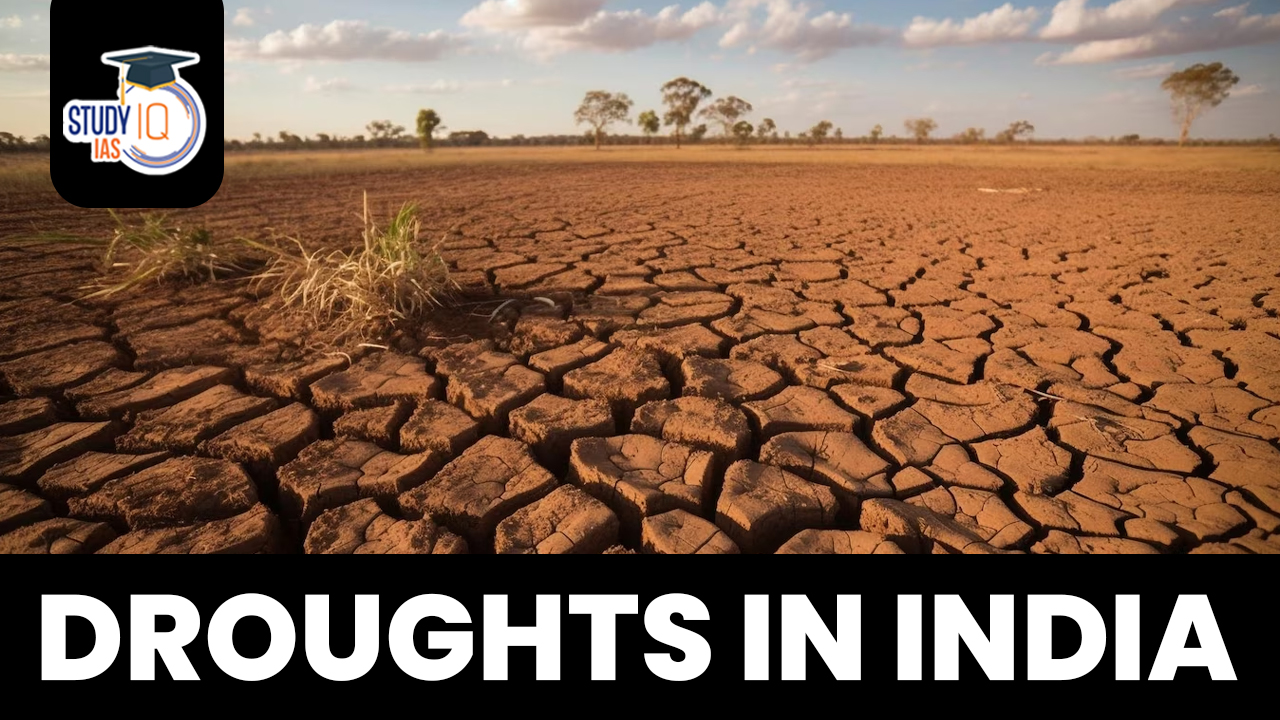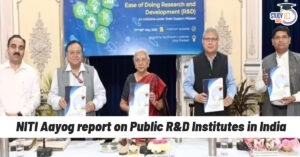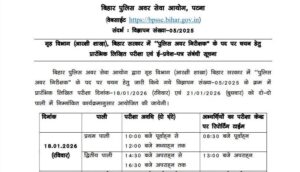Table of Contents
Context: The Karnataka state government is likely to declare more than 100 taluks as drought-hit in view of a severe shortage of rainfall.
Understanding Droughts
Droughts:
- Droughts are prolonged periods of abnormally low rainfall or water scarcity, leading to water shortages and adverse impacts on the environment, agriculture, and society.
- The India Meteorological Department (IMD) defines drought in any area when the rainfall deficiency in that area is ≥26% of its long term normal.
- It is further classified into moderate and severe drought depending upon whether the deficiency is between 26 to 50% and more than 50% respectively.
- For the country as a whole, the area-weighted rainfall having normal of 88 cm, also called Indian summer monsoon rainfall (ISMR), is considered.
- When the rainfall deficiency exceeds 10% and when the area under drought exceeds 20% of the total area of the plains in the country (which is 32,87,782 km2 ), such a situation is considered as drought for the country as a whole.
Types of Droughts
Meteorological Drought
- When there is a prolonged period of inadequate rainfall marked with maldistribution of the same over time and space it is called Meteorological Drought.
- Rainfall less than 90 percent of average is categorized as meteorological drought.
Agricultural Drought
- Agricultural Drought is characterized by low soil moisture that is necessary to support the crops, thereby resulting in crop failures.
- If an area has more than 30 percent of its gross cropped area under irrigation, the area is excluded from the drought-prone category.
- An extreme agricultural drought can lead to a famine, which is a prolonged shortage of food in a restricted region causing widespread disease and death from starvation.
- The government also declares an area affected by drought, if more than 50 percent crop loss happens in an area due to meteorological conditions.
Hydrological Drought
- When the availability of water in different storages and reservoirs like aquifers, lakes, reservoirs, etc. falls below what the precipitation can replenish.
Ecological Drought
- When the productivity of a natural ecosystem fails due to shortage of water and as a consequence of ecological distress, damages are induced in the ecosystem.
Causes of Droughts
Droughts can result from a combination of natural and human-caused factors.
Natural Factors:
- Erratic Monsoons: The South-west monsoon, which brings the majority of India’s annual rainfall, can be inconsistent. The failure of monsoons, often due to phenomena like El Niño, can lead to extended periods of reduced rainfall and drought conditions.
- Skewed Distribution of Monsoon: Some regions, such as the leeward side of the Western Ghats, receive less rainfall due to the geographical distribution of monsoons. This chronic uneven distribution can make certain areas more prone to drought.
- Depletion of Water Resources: Areas with low annual rainfall can experience a depletion of both surface and subsurface water resources. Inadequate rainfall doesn’t recharge these resources sufficiently, leading to water scarcity.
Anthropogenic (Human-Caused) Factors
- Inappropriate Agricultural Practices: Excessive water use in agriculture, particularly when cultivating water-intensive crops, can deplete local water supplies. Poor water management practices can worsen water scarcity.
- Deforestation and Wetland Encroachment: Activities like deforestation and the encroachment of wetlands reduce the natural ability of the land to retain water. Trees and wetlands play crucial roles in retaining water in the ecosystem.
- Global Warming and Climate Change: Human activities, such as the emission of greenhouse gases, contribute to global warming and changes in climate patterns. This can lead to fluctuations in monsoon patterns and exacerbate drought conditions.
Social and Economic Factors
- Population Growth: As the population increases, the demand for water also rises. This can strain existing water resources, especially in areas with limited water availability.
- Urbanization: Rapid urbanization can lead to increased water demand for industrial, residential, and commercial purposes, further stressing water resources.
- Water Management Policies: Inefficient water management policies, including inadequate infrastructure for water storage and distribution, can contribute to water scarcity during periods of reduced rainfall.
Drought Prone Areas in India
- In India, around 68% of the country is prone to drought in varying degrees.
- 35% which receives rainfall between 750 mm and 1125 mm is considered drought prone while 33% receiving less than 750 mm is chronically drought prone.
- The Indian Meteorological Department (IMD) classifies drought-prone areas in India into three categories based on the probability of drought occurrence, as given below:
- Chronically drought affected areas:
- Areas having a probability of drought exceeding 20% has been defined as chronically drought prone.
- In other words, such regions can expect at least one drought in 5 or 4 years.
- Chronically drought prone areas in India mainly include west Rajasthan and the entire State of Gujarat.

- Frequently drought prone areas:
- Areas having drought probability between 10% to 20% have been assigned this category.
- These areas are east Uttar Pradesh, Uttaranchal, Haryana, Punjab, Himachal Pradesh, east Rajasthan, west Madhya Pradesh, Marathwada, Vidarbha, Telangana, coastal Andhra Pradesh and Rayalaseema and can expect drought once in 6 to 10 years.
- These areas generally belong to sub-humid climate zones (both dry & moist).
- Least drought affected areas:
- Areas having drought probability less than 10% belong to this category and comprise the rest of the country.
- Apparently, these pose no problem from rainfall point of view as they mostly belong to per-humid and humid regions climatic zones.
Drought in Numbers 2022 Report
According to the 15th Conference of Parties (CoP15) to the United Nations Convention to Combat Desertification (UNCCD):
- Increase in area: India’s drought-prone area has increased by 57% since 1997. Drought affected nearly two-thirds of the country from 2020 to 2022.
- Increase in intensity: Over the last decade, one-third of India’s districts have experienced more than four droughts, and drought affects 50 million people each year.
- Comparison with Africa: Drought vulnerability in India is comparable to that of Sub-Saharan Africa.
- ISRO evaluation: According to the Desertification and Land Degradation Atlas of India, released in 2021 by the Space Applications Centre of ISRO, 97.85 million hectares i.eNearly 30% of the country’s land was degraded during 2018-19.
- Flash Droughts: According to the paper published recently in Nature Communications, India is a hotspot for flash droughts and this could have major implications on the country’s crop production.
- Flash droughts have been defined in two ways, either as a short-lived yet severe event where soil moisture completely depletes or a multi-week period of rapid intensification toward drought. It is sometimes also defined as a rapidly developing drought event.
Impact of Droughts
As per the Drought in Numbers 2022 Report,
- Water shortage: By 2050, droughts may affect more than three-quarters of the world’s population, with an estimated 4.8-5.7 billion people living in water-scarce areas for at least one month each year, up from 3.6 billion today.
- Migration: By 2030, drought will displace an estimated 700 million people worldwide.
- Mortality: Drought has killed over 10 million people over the last century. 90% of these deaths have occurred in developing countries.
- Poverty: A 2006 study reported that nearly 13 million people in Chhattisgarh, Jharkhand and Odisha who live just above the poverty line have fallen below it due to drought-related income loss and lost nearly $400 million during a severe drought year.
- Agriculture impact: On India’s primarily rainfed agriculture which accounts for 60% of the sown area on average.
- Food insecurity: An IPCC assessment noted that India’s rice output may decrease 30% and Maize production by 70 per cent if global warming rises to 4°C above pre-industrial levels and drought occurs due to the same.
- Economic impact: The report also stated that India’s GDP reduced by 2 to 5% between 1998 and 2017 due to severe droughts. Globally, droughts in the same period caused economic losses of approximately $124 billion.
- Impact Fauna: Australia’s megadrought in 2019-2020 contributed to “megafires” resulting in about three billion animals being killed or displaced. On a related note, 84% of all terrestrial ecosystems are threatened by changing and intensifying wildfires.
- Impact Flora: According to a 2017 report by FAO, the percentage of plants affected by drought has more than doubled in the last 40 years. Around 12 million hectares of land are lost each year due to drought and desertification.
- Gender-specific impact: Women (72%) and girls (9%) are disproportionately affected by water scarcity.
- Affect children: Almost 160 million children are exposed to severe and prolonged droughts due to water scarcity.
Government Initiatives
- Drought Prone Areas Programme (DPAP): Launched in the early 1970s, DPAP targeted the development of drought-prone areas by implementing measures to improve soil and water conservation, afforestation, and agricultural practices. It aimed at reducing the vulnerability of these regions to droughts.
- Desert Development Programme (DDP): Similar to DPAP, DDP focused on addressing the challenges posed by desertification and ecological degradation in desert regions. It aimed at restoring and conserving the ecology of hot and cold deserts through sustainable practices.
- Watershed Development: In response to the 1987 drought, the government shifted its focus to long-term solutions, particularly watershed development. DPAP and DDP were restructured to integrate watershed development as a primary unit for drought-proofing. This approach aimed to conserve rainwater, improve soil fertility, and enhance overall ecosystem health.
- National Watershed Development Programme for Rain-fed Areas (NWDPRA): This program aims to develop rain-fed areas through integrated watershed management practices. It focuses on soil and water conservation, afforestation, and enhancing livelihoods for local communities.
- Watershed Development Programme for Shifting Cultivation (WDPSC): This initiative addresses the challenges of shifting cultivation by promoting sustainable agricultural practices and watershed management in such regions.
NDMA Guidelines on Management of Drought
The NDMA guidelines on management of drought were issued in 2010. It is observed in the guidelines that state intervention in drought management has a significant positive impact. Some of the recommendations in the guidelines are as follows:
- Separate Drought Monitoring Cells (DMCs) should be created at the state level under the control of State Disaster Management Authorities which will prepare vulnerability maps in collaboration with the National Remote Sensing Centre.
- A control room should be established for drought management and specific guidelines should be issued for the use of Information and Communication Technology (ICT) for real time information related to droughts.
- The Government of India should undertake the watershed development approach through various programs.
- A cloud seeding policy may be considered at the national level.
- Cloud seeding, also known as a weather modification technique is an artificial way to induce moisture in the clouds so as to cause rainfall. In this process silver iodide, potassium iodide or dry ice (solid carbon dioxide) is dumped onto the clouds causing rainfall.
- Assessment of damage must be done in terms of agricultural production, depletion of water resources, livestock population, land degradation and deforestation as well as human health.
- To support income credit should be provided promptly including consumption loan.
- Insurance products will be developed for different agro-climatic zones providing coverage against drought.
- Afforestation with subabul, seemaruba, casurina, eucalyptus and biodiesel plantation like jetropha and pongomia will be encouraged.
- A realistic national training and capacity building programme for drought management should be formulated and implemented.
- In case of late monsoons or dry spells, seeds with short duration varieties should be made available on subsidy. Inter-cropping, mulching, and weeding should be promoted.
- For animals, creation of fodder banks, use of tank bunds, undertaking market intervention to keep fodder prices stable must be done.


 NITI Aayog Report on Public R&D Inst...
NITI Aayog Report on Public R&D Inst...
 Bihar Police SI Exam Date 2025 Out: Chec...
Bihar Police SI Exam Date 2025 Out: Chec...
 Delhi Police Admit Card 2025 Out – Dow...
Delhi Police Admit Card 2025 Out – Dow...

























